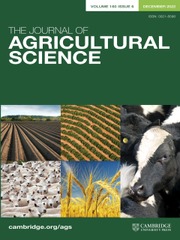Article contents
The effect of concentrate composition and method of silage feeding on intake and performance of lactating dairy cows
Published online by Cambridge University Press: 27 March 2009
Summary
Ninety-nine lactating British Friesian cows, in their second and subsequent lactations, were divided into two groups receiving ad libitum grass silage. The cows in group A were offered silage individually through Calan Broadbent gates while those in group B were given 24 h/day access to a self-feed silage clamp. The crude protein (CP), acid-detergent fibre (ADF), neutral-detergent fibre (NDF), in vitro digestible organic matter and estimated metabolizable energy (ME) values in the D.M. of the silage were 140, 373, 584, 610g/kg D.M. and 9·7 MJ/kg D.M. respectively. The cows in each group received either 11kg/day fresh weight of concentrate S in which the principal energy source was cereal starch or 9 kg/day fresh weight of concentrate F containing mixed high quality fibre sources plus 2 kg/day fresh weight of concentrate S. The CP, ADF, NDF, starch and sugar concentrations in concentrates S and F were 203, 71, 204, 444, and 44 and 202, 147, 329, 116 and 149g/kg D.M., respectively.
The only significant difference produced by method of silage allocation was that groupfed cows gained more live weight (P < 0·01) than those fed individually.
Over the whole experimental period the mean silage D.M. intake of cows fed concentrate F in group A was 0–5 kg/day higher than those fed concentrate S. However, in early lactation the benefit to silage intake in favour of concentrate F was 1 kg D.M./day.
In group A estimated intakes derived from calculated ME inputs and outputs were markedly lower than the observed intakes, but were similar to correspondingly derived estimates for group B.
Although concentrate type did not affect milk yield, concentrate F was associated with a higher fat concentration and yield (P <0–05) but a lower protein concentration (P < 0·001) and a slightly lower yield.
The in vivo digestibility coefficients for D.M. and organic matter determined in lactating dairy cows given concentrates S and F respectively were similar (0·724 v. 0·716 and 0·749 v. 0·742) but that for ADF was significantly (P < 0·001) higher (0·565 v. 0·673) in the ration containing concentrate F than in that containing concentrate S.
Estimates of the mean efficiency of utilization of the production ME made on a weekly basis were unaffected by concentrate type.
Information
- Type
- Research Article
- Information
- Copyright
- Copyright © Cambridge University Press 1987
References
- 31
- Cited by

